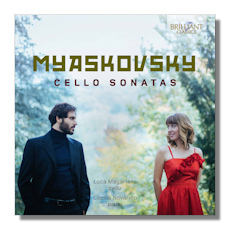
The Internet's Premier Classical Music Source
Related Links
-
Myaskovsky Reviews
- Latest Reviews
- More Reviews
-
By Composer
-
Collections
DVD & Blu-ray
Books
Concert Reviews
Articles/Interviews
Software
Audio
Search Amazon
Recommended Links
Site News
 CD Review
CD Review
Nikolay Myaskovsky

Cello Sonatas
- Sonata for Cello & Piano #1 in D Major, Op. 12
- Sonata for Cello & Piano #2 in A minor, Op. 81
Luca Magariello, cello
Cecilia Novarino, piano
Brilliant Classics 5041979
This sensitive and original set of interpretations of Nikolai Myaskovsky's two Cello Sonatas by Luca Magariello (cello) and Cecilia Novarino (piano) should make you happy that the composer joined the list of those who successfully resisted their families wish for them to pursue a career in disciplines other than music. There is an immediacy and transparency to Magariello's and Novarino's playing which perhaps reflects the extent to which the Italian tradition to which they belong privileges emotion and spontaneous expression over attempts to recreate the cultural hotbed of the society in which Myaskovsky wrote the two works.
The first Cello Sonata in D Major (Opus 12) was written in 1911 and revised 1935; the second in A minor (Opus 81) in 1948. Yet neither turmoil nor fear stalks the sonatas' 22 and 25 minutes of sinuous late romantic intimacy. It's an intimacy which does, though, look outwards; and is acknowledged here as fresh and yet confident. Listen to the way the dynamic is allowed to build towards the middle of the D Major's allegro appassionato second movement [tr.2] much as in the way that Schumann and Mendelssohn piled restrained passion on relatively simple melodic motifs.
These sonatas also have a searching quality. As though walkers were but imagining dense undergrowth in a forest in which under the trees lay not thick – but merely unfamiliar – vegetation. And not quite understanding why the going was easier than it ought to be. Another contrast useful in contextualizing this unpretentious music is that between majesty (as in the unison progression – perhaps approached with slightly too much plain force by these players – towards the end of that same movement) and a mellow warmth which appears to be paid out by Myaskovsky more than it really is. The composer here to whom one refers for a parallel is Richard Strauss, whom he loved.
Indeed, the wistful melodic winding of Strauss can be heard in the second Sonata which was written only two years before Myaskovsky's death. Again, the Russian aims at less happy dissembling than the German does. His melodies and textures are more open; they make closer reference to the somewhat more innocent worlds of his teachers at the St Petersburg Conservatoire, Rimsky-Korsakov, Lyadov and Glazunov than they do to Wagner and Mahler. As if Strauss had gone too far in distilling the lushness of the high German Romantics both in terms of their thematic structures and highly pared down instrumentation.
This is not music in miniature; though Magariello and Novarino do content themselves with clarity and courtesy rather than density or dolefulness. The sound world is even more redolent of Debussy than of Stravinsky or Prokofiev. Listen to the way in which the theme of the second Sonata's andante cantabile [tr.4] seems happy to wrap itself around itself yet not… "look back".
Given that Myaskovsky – with his 27 symphonies occupies a somewhat anomalous position in twentieth century Russian music, indeed, given that the final movement of the Second Sonata has something of the symphonic about it (in its sense of attack and purpose, though not in scale), Magariello and Novarino have done well to use technique and an understanding of just how wise they were not to read anything into the music which wasn't there; and in making it spontaneous and appealing and letting it go its own way at its own pace and not that of Brahms or Franck.
The acoustic is dry; maybe a little too dry and lacking a little resonance. It emphasizes the intimacy and immediacy of the performances. But at the cost of the dynamism which surely music that blends so many characteristics needs. The short booklet has commentaries on the two sonatas and bios of Magariello and Novarino. The Second Sonata in particular was one which Rostropovich championed. His recording is to be preferred (it's currently only available as part of the "Cellist of the Century" set, Warner Classics 559857). There are other CDs devoted to the works. But these are fresh, lively, accurate and clear interpretations that would make a feasible introduction to a composer who is difficult to categorize or characterize but repays attention.
Copyright © 2017, Mark Sealey



















